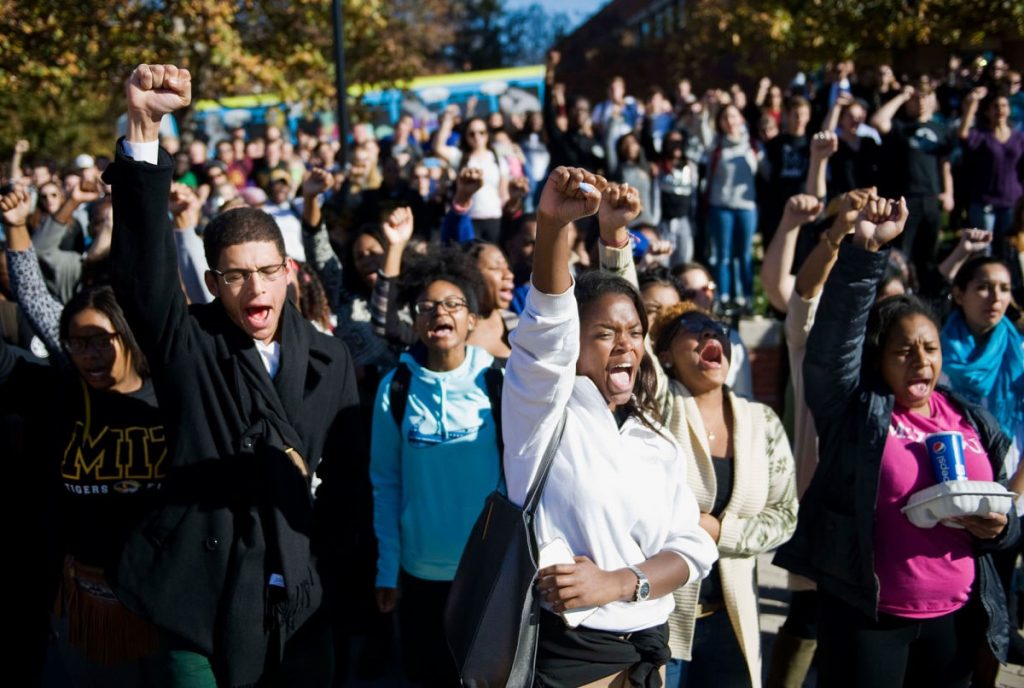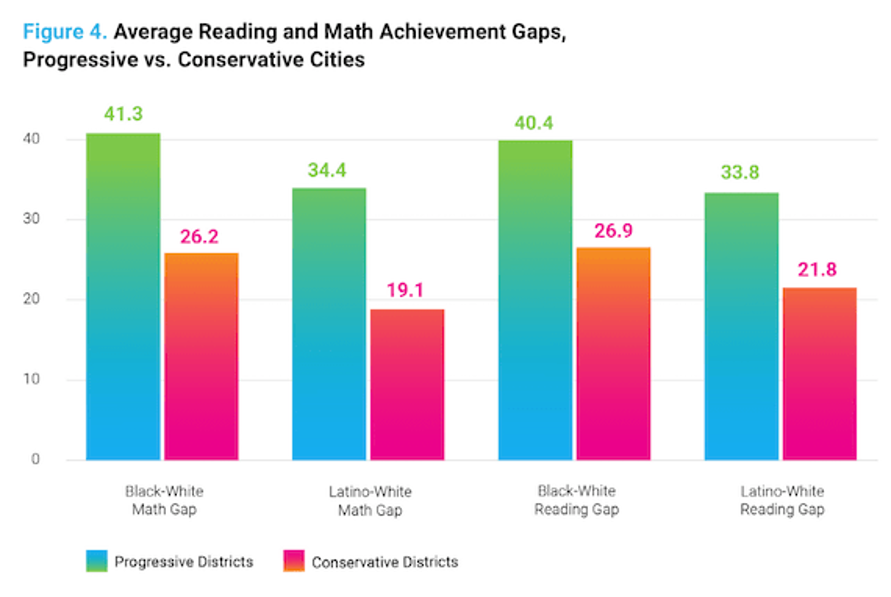
Progressive policies cause the racial achievement gaps that progressives spend so much time lamenting. That’s the conclusion of Minnesota lawyer and think-tank president John Hinderaker, based on recent educational research. He cites a report from Brightbeam, “The Secret Shame: How America’s Most Progressive Cities Betray Their Commitment to Educational Opportunity For All.” The report is authored by Chris Stewart, a liberal activist from Minnesota. He studied why the progressive public schools in Minneapolis’s biggest cities have among the country’s worst achievement gaps between white and black students. Brightbeam describes itself as “a network of education activists demanding a better education and a brighter future for every child.”
Stewart compared achievement by race in various cities classified as progressive or conservative. Conservative cities (as ranked by political scientists) consistently did a more effective job of shrinking student achievement gaps–occasionally, to zero–than progressive cities. The figure below summarizes the findings:
Brightbeam looked at a number of variables that it thought might help to explain these findings. It concluded that “of all the factors we looked at, progressivism is the greatest predictor.”
The Brightbeam study did not attempt to explain which particular progressive policies caused these disparities. But it did call on progressive school districts to rethink their assumptions. At Bacon’s Rebellion, the longtime journalist James A. Bacon suggests some likely causes:
* Agency. By blaming racism and discrimination for the woes afflicting minority communities, progressives deprive minority students of agency — the sense that they control their own destinies and that their efforts will make a difference. If minority students see themselves as victims of systemic racism, why bother working hard and “acting white”?
* Discipline. Progressives have implemented “social justice” approaches to school and classroom discipline on the grounds that suspensions and other punishments disproportionately affect minorities. The resulting breakdown in classroom discipline has the perverse effect of disproportionately harming the minority students whose classes are being disrupted.
* Lower standards. As an offshoot of the “self esteem” movement, progressive educators don’t want to damage the self-esteem of minority students. Accordingly, they have lower expectations and set lower standards for minorities to offset the advantages that white students have from “white privilege.”
Research supports Bacon’s theory that breakdowns in classroom discipline resulting from progressive policies worsen the racial achievement gap. In New York City, suspensions were curbed by progressive school officials. The result? Minority students suffered most, as classroom disruption increased at the expense of their ability to learn. Manhattan Institute researcher Max Eden found that “schools where more than 90% of students were minorities experienced the worst” effects on school climate and safety due to restrictions on suspensions. It is predominantly-minority schools that are most often plagued by chronically disruptive students who make it difficult for their classmates to learn.
Other studies have also found that progressive officials’ refusal to suspend chronically disruptive students increases the racial achievement gap. As Eden noted in the New York Post, a “study by a University of Georgia professor found that efforts to decrease the racial-suspension gap actually increase the racial achievement gap.” That research found that “in public schools with discipline problems, it hurts those innocent African American children academically to keep disruptive students in the classroom,” and “cutting out-of-school suspensions in those schools widens the black-white academic achievement gap.”
In some places, progressives have curbed suspensions for violent or chronically defiant or disruptive students based on the assumption that suspensions must be racist, because it is disproportionately black students who are suspended. But racial differences in suspension rates don’t prove racism as appeals courts in Philadelphia, Chicago, and Richmond have noted. Instead, the differences in suspension rates reflect the fact that black kids are more likely to come from struggling single-parent households that fail to instill discipline. As the liberal Brookings Institution conceded in 2017, “Black students are also more likely to come from family backgrounds associated with school behavior problems.”
Education reporters, who are a staunchly progressive lot, have mostly ignored the Brightbeam study. But a few newspapers have recognized its findings. One example is an op-ed in the Minneapolis Star Tribune by liberal activist Nekima Levy Armstrong, titled “Research shows progressive places, like Minneapolis, have the worst achievement gaps.” Armstrong describes the findings of the Brightbeam study:
The Brightbeam report shows that progressive cities like Minneapolis do worse — and, surprisingly, conservative cities do better — when it comes to educating students of color. According to the report, conservative cities have gaps in math and reading that are on average 15 and 13 percentage points smaller than those in progressive cities.
***
Researchers also controlled for other factors that could potentially explain different educational outcomes, including poverty rates, population size, per-pupil spending and private school attendance rates. Surprisingly, none of these other variables made a difference in predicting the size of the opportunity gap.
What mattered most was whether the city was conservative or progressive. In three of the most conservative cities — Anaheim, Fort Worth and Virginia Beach, researchers found that leaders have either closed or eliminated opportunity gaps in either reading, math or high school graduation rates. Meanwhile, in our own “progressive” city of Minneapolis, the report showed that the shameful gap in math achievement between black and white students in K-12 is 53 percentage points, while the gap in math between brown and white students is 45 points.

When growing up in the 40’s & 50’s, 90% of black families had a nuclear family, married mother & father with children. The report mentions the breakdown of parental discipline, specifically mentioning singly parent family. Sadly, during the Great Society welfare programs, the government financially replaced the Father making him irrelevant. The rise of youth oriented gangs exploded where some found safety & a sense of family. Welfare is a scourge not a saviour.
A related question is how individual success is measured.
If success is measured on an individual basis, e.g. as on the the basketball court where it’s ones individual proficiency as a player, then its one’s individual proficiency that is measured. However, once we go to quotas of any sort, then we then find ourselves dealing with the issue of who is more oppressed than whom, and the endless bitterness of cycles of oppression.
Why is the fact that conservative cities do better in educating students of color surprising?
The curse of low expectations, compounded with the error of celibrating mediocrity.